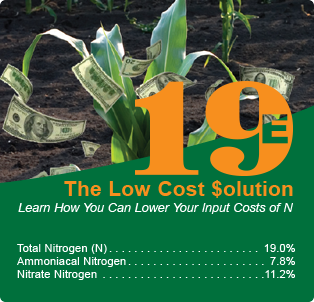In 2001, R.W. Griffin and Engelhard Chemical, one of the largest chemical companies in the world (now owned by BASF) entered into a long term exclusive distributorship for BASF’s 19-E fertilizer produced around the clock at Attapulgus, Georgia.
R.W. Griffin’s ability to win a very sought after contract with BASF was based on its’ ability and commitment to provide significant storage and logistical assistance for BASF’s product.
19-E is a popular product for our Southeast farmers providing them needed inputs at a very reasonably priced cost. Farmers have been using the product with success for almost 40 years.
Benefits
- No risk of potential N loss due to volatilization.
- Lower cost per pound of N
- Nitrate-N for rapid crop absorption
- Premix with ammonium thiosulfate to provide both N and S as 18-0-0-3
Corn and Forage Grasses need N all season long for top-profit yield
- Specialists suggest about 200 lbs of NITROGEN for 150 bu/a corn and about 275 lbs for 200 bu/a corn. For higher yields, consider 1.2 lbs of N for every bushel of expected corn grain yield.
- Split apply N for corn with 50-75 lbs applied preplant and the remainder split at 12″ ht. and then several times through the pivot.
- An 8 ton/a yield of bermuda needs at least 400 lbs/a each of N and of K20.
- Hay responds well to 75 lbs/a of N applied pre-1st cut and then 100 lbs/a of N applied right after each cutting. POTASSIUM and SULFUR are essential for efficient crop use of N. 16-0-5 (a mix of 19-E and soluble potash) helps to provide a part of the crop’s K needs.
- Bermuda needs 50-60 lbs/a of K20 for each ton of anticipated hay yield
- Remove animals from pastures for a week after the application of 19E or until the field receives 1/2 inch of rain or irrigation water
From Scientists and Consultants to Retailers and Growers, Here’s What They’re Saying about 19E Fertilizer
- It works and better yet, it costs less…
- Comparisons of 19E to Urea and Ammonium Nitrate showed that they are equally effective when applied properly and at the same rate of nitrogen…
- I sidedress cotton with 19E or 18-0-0-3 because it is more economical and there is no risk of N loss due to volatilization…
- Compatible herbicides can be mixed with 19E for uniform application and better weed control…
- I have sold it for years because it is the best value per acre to the grower…
- For years my cotton growers have benefitted when I mix soluble potash and ammonium thiosulfate with 19E to produce a 14-0-4-2s. This prevents N loss by volatilization, provides a uniform application and eliminates the risk of leaf burn.
- …this mix of and potash also works well on pastures and hay fields
Consider these nitrogen management facts:
- Nitrogen is the element most often limiting pecan growth
- Pecans need about 150 to 200 pounds per acre of Nitrogen split applied
- Split apply Nitrogen before spring bud break and again during early kernel fill
- Potassium (K) and N allow leaves to build sugar reserves until frost
- A buildup of sugars and nutrients helps to minimize alternate year bearing
- Nitrate and ammonium N sources are equally effective when each is properly applied and at the same rate of Nitrogen.


